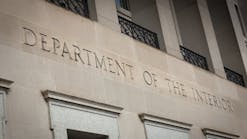BLM pulls proposed fracing rules, works on new version
The US Bureau of Land Management withdrew its proposed hydraulic fracturing regulations and announced that a new draft will be prepared during 2013’s first quarter. BLM is preparing a new version in response to the more than 170,000 comments it received to the original proposal, the US Department of the Interior said on Jan. 18.
“In response to comments from stakeholders and the public, BLM is making improvements to the draft proposal in order to maximize flexibility, facilitate coordination with state practices and ensure that operators on public lands implement best practices,” a DOI spokesman said. Additional comments will be sought on the new proposal once it is issued, he added.
The draft that was withdrawn was issued in May 2012, and the public comment period on it closed in September. BLM began revising the draft soon after in response to concerns which were raised and to incorporate suggestions which were received, and will submit revisions to the White House Office of Management and Budget for review within a week, according to a DOI source.
The source said the new draft rule will include the original’s three main components: requiring operators to disclose chemicals they use in fracing operations on public lands; improving assurances on wellbore integrity to verify that fracing fluids used in wells are not escaping; and confirming that oil and gas operators have a water management plan in place for handling fracing fluids that flow back to the surface.
BLM plans to issue final rules after it considers public comments on the new draft later this year.
Positive first step
Two oil and gas associations applauded the move. American Petroleum Institute Pres. Jack N. Gerard noted that API asked BLM to reconsider the original proposal, and welcomes the move as “a positive first step.”
Gerard said, “However, the real test will be in the substance of the reproposal. We hope the administration will recognize the strong oversight provided by existing state and federal regulations and take sufficient time to review the many thoughtful comments provided by the oil and natural gas industry and others.”
In Denver, the Western Energy Alliance applauded BLM’s decision to develop a fresh draft since the original was so complex, and technical input from producers, Indian tribes, governors, and Congress supplied some good ideas.
“BLM has wisely resisted political pressure to rush through a highly complex and controversial rule,” said Kathleen Sgamma, WEA’s vice-president of government and public affairs. “We continue to believe a federal fracing rule is not necessary, as states have been effectively regulating for decades with an exemplary health, safety, and environmental record.
She said WEA found that the first draft would add more than $250,000 to the cost of each new well for an aggregate annual cost of $1.5 billion. “We hope BLM’s next steps include a thorough cost assessment to balance the regulatory burden with the impact on jobs and economic growth,” Sgamma said, adding, “A true assessment would reveal that BLM should not usurp state regulatory authority at a time of overwhelming federal debt and declining budgets.”
Contact Nick Snow at [email protected].

Nick Snow
NICK SNOW covered oil and gas in Washington for more than 30 years. He worked in several capacities for The Oil Daily and was founding editor of Petroleum Finance Week before joining OGJ as its Washington correspondent in September 2005 and becoming its full-time Washington editor in October 2007. He retired from OGJ in January 2020.

